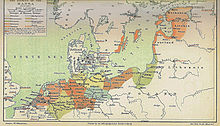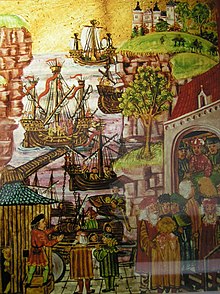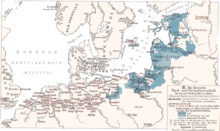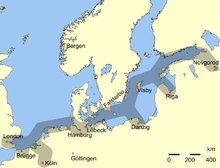Hanseatic League
![]()
This article describes the historical trade alliance. For other meanings, see Hanseatic League (disambiguation).
Hanseatic League (also German Hanseatic League or Düdesche Hanseatic League, Latin Hansa Teutonica) is the name for the associations of mainly North German merchants existing between the middle of the 12th century and the middle of the 17th century, whose aim was the safety of passage and the representation of common economic interests, especially abroad. The Hanseatic League was an important factor not only in the economic field, but also in the political and cultural fields.
A development from the "Kaufmannshanse" to a "Städtehanse" can be established at the latest in the middle of the 14th century with the first almost pan-Hanseatic day trips (Hansetagen), in which the Hanseatic cities joined together and represented the interests of the North German merchants. However, the exact demarcation between "merchant Hanse" and "city Hanse" is disputed.
The colours of the Hanseatic League (white and red) can still be found today in the coats of arms of many Hanseatic cities. At the time of its greatest expansion, almost 300 maritime and inland cities of northern Europe were united in the Städtehanse. An important basis of these connections was the development of transport, especially to sea, which is why the cog became the symbol of the Hanseatic League. Through free trade, many Hanseatic cities achieved great wealth, which can still be seen today in numerous important buildings.
Other merchant associations as far away as Austria also called themselves "Hanse" or "Hänse", independently of the "great" North German Hanseatic League. As a rule, these were not political alliances between cities and territories, but rather brotherhoods that individual merchants joined. Often such alliances were geared to a specific fair and took over economic control functions during its duration, as they were carried out by the guilds in larger cities.

North and Baltic Sea Region and the Hanseatic Cities around 1400

Illustration from the Hamburg city charter of 1497

The Hanseatic Cities and the Teutonic Order in the 14th Century and the Beginning of the 15th Century
Word Origin
The name Hanseatic League derives from the Old High German word hansa, which in the High Middle Ages became the translation of the Latin cohors ("retinue, band, group"), the earliest documented proper name of the Hanseatic League. The previous Common Germanic *hanso probably referred to "a community with an overall coffers and whereby meals were eaten together". Compare Gothic hunsl ("sacrificial meal") and Swiss German hans ("drinking party"). The Finno-Ugric languages also took *hanso from the early Germanic languages, compare Finnish kansa ("people"), Karelian kanža ("gathering"), and Estonian kāz(a) ("comrade, consort").
Organization
The capital Lübeck, in the late Middle Ages next to Cologne and Magdeburg one of the largest cities in the empire and next to Rome, Venice, Pisa and Florence one of the five dominions of the empire, according to the edict of Emperor Charles IV was court of appeal for all Hanseatic cities, which had to judge according to their own Lübische law.
Hansa Convention
→ Main article: Hansa Convention
The general Hansa Convention was the highest governing and decision-making body of the Hanseatic League. The first Hansa Convention took place in 1356, the last in 1669 (see also Hansa Conventions of Modern Times).
Hanseatic congresses were held as needed, usually at the invitation of Lübeck, which in 1294 was unchallenged as caput et principium omnium and was confirmed as hovestad of the Hanseatic League several times in the 14th and 15th centuries. However, Lübeck could not derive any special rights vis-à-vis the other cities of the Hanseatic League from this function.
The Hansa Convention dealt with all questions concerning the relationship between merchants and cities and their relations with trading partners abroad. The idea was that the resolutions should be binding for all members.
But the Hanseatic League did not have any coercive power over the cities. The implementation of the resolutions depended on the good will of the cities; it was solely at their discretion to support the resolutions of the Hansa Convention or to go their own way. They therefore felt bound only if the resolutions coincided with their own local interests, otherwise they refused to cooperate. One example is Dortmund's refusal to join the war alliance of the Wendish, Prussian and some Dutch cities against the Danish King Waldemar IV, which was concluded in Cologne in 1367 and was so momentous for the history of the Hanseatic League. In a letter to the council messengers assembled in Lübeck, the city stated that it had never supported the wars of the maritime cities and did not want to do so now. Conversely, in 1388 the other Hanseatic cities, even those of Westphalia, left Dortmund alone when its sovereignty was at stake in the Great Feud and it was threatened by the assembled armies of the Archbishop of Cologne and the Count of the Mark. Similar examples abound.
All important matters concerning the members were dealt with at the individual Hansa Conventions, for example:
- Ratification of treaties
- Trade privileges
- Economic sanctions
- economic provisions of all kinds
- diplomatic activities of the Hanseatic League
- War and Peace
- financial or military measures
- Admission or exclusion of members
- Arbitration of conflicts between Hanseatic cities
- Consulting
Because of Lübeck's supremacy, 54 Hanseatic days were held there between 1356 and 1480. Ten Hanseatic days were held in Stralsund, three in Hamburg, two in Bremen, and one each in Cologne, Lüneburg, Greifswald, Brunswick (1427), and Uelzen (1470). For other Hanseatic days, see Hanseatic days of modern times.
Lübeck also generally took the initiative when it came to convening a Hansa Convention. The items on the agenda were always announced months in advance in order to give the individual cities or groups of cities sufficient time for consultation. Ultimately, Lübeck was unable to impose a fixed order as to which cities were to be invited, and accordingly invited different cities to the days - probably in accordance with the respective problem.
By and large, the cities had to bear the travel and accommodation expenses themselves. In order to minimize expenses, they tried to appoint syndici to represent their interests. At the Hansa Convention of 1418, however, it was determined that only the councillors of a city were entitled to represent their interests.
In July 1669, the last Hansa Convention took place in Lübeck, after the revival of the Hanseatic League had failed due to the Thirty Years' War or the inability of the League of Cities to develop viable power structures. Only nine delegates came, and they left again without passing any resolutions. The Hanseatic League was thus never formally dissolved, but ended "gently".
Third Day
Thirds' days were held to discuss especially Flanders-related issues and supplemented the Hanseatic days. The name is derived from the groups of cities called Drittel. In 1347, the existence of the Thirds was mentioned for the first time in the statutes of the Hanseatic Kontor in Bruges. The Kontor was administered in equal parts by the Lübeck-Saxon, Westphalian-Prussian and Gothic-Liveland cities. It is assumed that this division corresponded to the distribution of power within the Hanseatic League at that time. Each third was led by a city called Vorort. At the beginning these were: Lübeck, Dortmund and Visby. The London Kontor also had such an administration by thirds, but other (less important) Kontors did not.
Obviously it was advantageous to be the leading city within a third, because soon there were intra-Hanseatic disputes about the division and leadership of the thirds. Cologne replaced Dortmund in the leadership of the Westphalian-Prussian third. Between Visby and Riga the leading role in the Gothic-Livish third changed several times. The importance of Lübeck at that time is also shown by the fact that the leading role of the city in the most powerful Lusatian-Wendish Third was never challenged.
At the Hansa Convention in 1554, the thirds were made into quarters. From then on Lübeck led the Wendish quarter, Brunswick and Magdeburg the Saxon quarter, Danzig the Prussian-Liveland quarter and Cologne the Cologne quarter.
Regional Day
In addition to the Hanseatic and Third Days, so-called regional days were also held, at which the representatives of neighbouring towns met and also discussed non-Hanseatic matters. These regional days were organized by the councils of the participating cities. They were also responsible for implementing the decisions of the assemblies in the respective towns.

Main trade routes of the Hanseatic League in northern Europe
Questions and Answers
Q: What was the Hanseatic League?
A: The Hanseatic League was an alliance of trading guilds that established and maintained a trade monopoly over the Baltic Sea and most of Northern Europe.
Q: When did this monopoly last?
A: This monopoly lasted for a time in the later Middle Ages and Early Modern period, between the 13th and 17th centuries.
Q: What languages were used by members of the Hanseatic League?
A: Members of the Hanseatic League spoke German, Dutch, Estonian, Latvian, Polish and Swedish.
Q: How many cities were part of it?
A: Many cities were part of it.
Q: What type of organization was the Hanseatic League?
A: The Hanseatic League was an alliance of trading guilds.
Q: Where did this trade monopoly take place? A: This trade monopoly took place over the Baltic Sea and most of Northern Europe.
Search within the encyclopedia